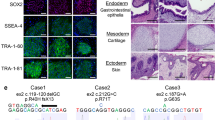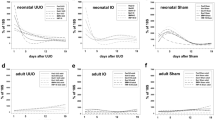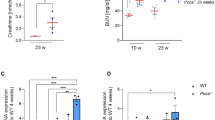Abstract
Metanephric kidney development requires an inductive interaction between the ureteric bud and progenitor mesenchyme, where the early expression of two genes, Wilms’ tumour 1 (WT1) and paired box 2 (Pax2), establishes critical but unknown developmental pathways. Indeed, transgenic mice with deregulated overexpression of Pax2 exhibit structural kidney defects and impaired renal function, as do mice harboring targeted disruptions and/or spontaneous mutations of either the Pax2 or WT1 genes. WT1 and Pax2 are thought to regulate each other's expression during renal development. To better define the relationship between WT1 and Pax2, we generated mouse embryos containing heterozygous mutations in both genes. WT1+/−/Pax21Neu/+ kidneys were 50% smaller than wild-type kidneys. They were characterized by severe attenuation of the renal medulla, and reduced development of calyces and the renal pelvis. Renal cortex development in compound heterozygotes culminated in fewer nephrons than in WT1+/−, Pax21Neu/+ or wild-type mice. Only minor variations in the mesenchymal expression pattern of Pax2 protein, and the mRNA expression levels of Pax2 and WT1, were noted in mutant kidneys. We show that WT1 and Pax2 proteins interact in vitro and in vivo, demonstrating that WT1 and Pax2 can form a molecular complex. Our data suggest that WT1 is a modifier of the Pax2 mutant phenotype.
This is a preview of subscription content, access via your institution
Access options
Subscribe to this journal
Receive 50 print issues and online access
$259.00 per year
only $5.18 per issue
Buy this article
- Purchase on SpringerLink
- Instant access to full article PDF
Prices may be subject to local taxes which are calculated during checkout





Similar content being viewed by others
References
Barbaux S, Niaudet P, Gubler MC, Grunfeld JP, Jaubert F, Kuttenn F, Fekete CN, Souleyreau-Therville N, Thibaud E, Fellous M and McElreavey K . (1997). Nat. Genet., 17, 467–470.
Bruening W and Pelletier J . (1996). J. Biol. Chem., 271, 8646–8654.
Dahl E, Koseki H and Balling R . (1997). BioEssays, 19, 755–765.
Dehbi M, Ghahremani M, Lechner M, Dressler G and Pelletier J . (1996). Oncogene, 13, 447–453.
Dressler GR, Deutsch U, Chowdhury K, Nornes HO and Gruss P . (1990). Development, 109, 787–795.
Dressler GR and Douglass EC . (1992). Proc. Natl. Acad. Sci. USA, 89, 1179–1183.
Drummond IA, Madden SL, Rohwer-Nutter P, Bell GI, Sukhatme VP and Rauscher III FJ . (1992). Science, 257, 674–678.
Eberhard D, Jimenez G, Heavey B and Busslinger M . (2000). EMBO J., 19, 2292–2303.
Eccles MR . (1998). Pediatr. Nephrol., 12, 712–720.
Englert C, Hou X, Maheswaran S, Bennett P, Ngwu C, Re GG, Garvin AJ, Rosner MR and Haber DA . (1995). EMBO J., 14, 4662–4675.
Evers P and Uylings HB . (1994). J. Histochem. Cytochem., 42, 1555–1563.
Favor J, Sandulache R, Neuhauser-Klaus A, Pretsch W, Chatterjee B, Senft E, Wurst W, Blanquet V, Grimes P, Sporle R and Schughart K . (1996). Proc. Natl. Acad. Sci. USA, 93, 13870–13875.
Gnarra JR and Dressler GR . (1995). Cancer Res., 55, 4092–4098.
Gundersen HJ, Bagger P, Bendtsen TF, Evans SM, Korbo L, Marcussen N, Moller A, Nielsen K, Nyengaard JR, Pakkenberg B, Sorensen FB, Vesterby A and West MJ . (1988). APMIS, 96, 857–881.
Hammes A, Guo JK, Lutsch G, Leheste JR, Landrock D, Ziegler U, Gubler MC and Schedl A . (2001). Cell, 106, 319–329.
Herzer U, Crocoll A, Barton D, Howells N and Englert C . (1999). Curr. Biol., 9, 837–840.
Kim J, Lee JM, Branton PE and Pelletier J . (2000). FEBS Lett., 474, 121–128.
Kreidberg JA, Natoli TA, McGinnis L, Donovan M, Biggers JD and Amstutz A . (1999). Mol. Reprod. Dev., 52, 366–375.
Kreidberg JA, Sariola H, Loring JM, Maeda M, Pelletier J, Housman D and Jaenisch R . (1993). Cell, 74, 679–691.
Lechner MS, Levitan I and Dressler GR . (2000). Nucleic Acids Res., 28, 2741–2751.
Lee SB and Haber DA . (2001). Exp. Cell Res., 264, 74–99.
Lee TH, Lwu S, Kim J and Pelletier J . (2002). J. Biol. Chem., 277, 44826–44837.
Lee TH and Pelletier J . (2001). Physiol. Genom., 7, 187–200.
Little M, Holmes G and Walsh P . (1999). BioEssays, 21, 191–202.
McConnell MJ, Cunliffe HE, Chua LJ, Ward TA and Eccles MR . (1997). Oncogene, 14, 2689–2700.
Moore AW, McInnes L, Kreidberg J, Hastie ND and Schedl A . (1999). Development, 126, 1845–1857.
Muratovska A, Zhou C, He S, Goodyer P and Eccles MR . (2003). Oncogene. (accepted for publication).
Palmer RE, Kotsianti A, Cadman B, Boyd T, Gerald W and Haber DA . (2001). Curr. Biol., 11, 1805–1809.
Pelletier J, Bruening W, Kashtan CE, Mauer SM, Manivel JC, Striegel JE, Houghton DC, Junien C, Habib R, Fouser L, Fine RN, Silverman BL, Maber DA and Housman D . (1991). Cell, 67, 437–447.
Porteous S, Torban E, Cho NP, Cunliffe H, Chua L, McNoe L, Ward T, Souza C, Gus P, Giugliani R, Sato T, Yun K, Favor J, Sicotte M, Goodyer P and Eccles M . (2000). Hum. Mol. Genet., 9, 1–11.
Rupprecht HD, Drummond IA, Madden SL, Rauscher III FJ and Sukhatme VP . (1994). J. Biol. Chem., 269, 6198–6206.
Ryan G, Steele-Perkins V, Morris JF, Rauscher III FJ and Dressler GR . (1995). Development, 121, 867–875.
Sanyanusin P, Schimmenti LA, McNoe LA, Ward TA, Pierpont ME, Sullivan MJ, Dobyns WB and Eccles MR . (1995). Nat. Genet., 9, 358–364.
Schedl A and Hastie ND . (2000). Curr. Opin. Genet. Dev., 10, 543–549.
Sim EU, Smith A, Szilagi E, Rae F, Ioannou P, Lindsay MH and Little MH . (2002). Oncogene, 21, 2948–2960.
Torres M, Gomez-Pardo E, Dressler GR and Gruss P . (1995). Development, 121, 4057–4065.
Werner H, Hernandez-Sanchez C, Karnieli E and Leroith D . (1995a). Int. J. Biochem. Cell. Biol., 27, 987–994.
Werner H, Shen-Orr Z, Rauscher III FJ, Morris JF, Roberts Jr. CT and LeRoith D . (1995b). Mol. Cell. Biol., 15, 3516–3522.
Wheat W, Fitzsimmons D, Lennox H, Krautkramer SR, Gentile LN, McIntosh LP and Hagman J . (1999). Mol. Cell. Biol., 19, 2231–2241.
Acknowledgements
We are grateful to Dr Jack Favor (Institute of Mammalian Genetics, Neuherberg, Germany) for kindly providing us with Pax21Neu C57BL/6 mice. Purchase of the Roche LightCycler was made possible through the generosity of the Fondation J-Louis Lévesque. MTD was supported by fellowships from FRSQ-FCAR and the McGill Faculty of Medicine during the course of this work. ME is a James Cook Research Fellow of the Royal Society of New Zealand, and JP is a Canadian Institutes of Health Research (CIHR) Senior Investigator. This work was supported by grants from the Canadian Institutes of Health Research (CIHR) to JP, and the Cancer Society of New Zealand to ME.
Author information
Authors and Affiliations
Corresponding author
Rights and permissions
About this article
Cite this article
Discenza, M., He, S., Lee, T. et al. WT1 is a modifier of the Pax2 mutant phenotype: cooperation and interaction between WT1 and Pax2. Oncogene 22, 8145–8155 (2003). https://doi.org/10.1038/sj.onc.1206997
Received:
Revised:
Accepted:
Published:
Issue date:
DOI: https://doi.org/10.1038/sj.onc.1206997
Keywords
This article is cited by
-
PAX2 is dispensable for in vitro nephron formation from human induced pluripotent stem cells
Scientific Reports (2017)
-
PAX genes in childhood oncogenesis: developmental biology gone awry?
Oncogene (2015)
-
Successful minimally-invasive management of a case of giant prostatic hypertrophy associated with recurrent nephrogenic adenoma of the prostate
BMC Urology (2013)
-
Temporal blastemal cell gene expression analysis in the kidney reveals new Wnt and related signaling pathway genes to be essential for Wilms' tumor onset
Cell Death & Disease (2011)



